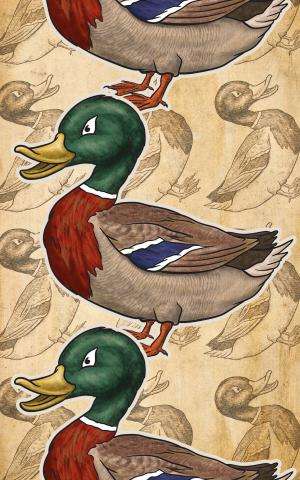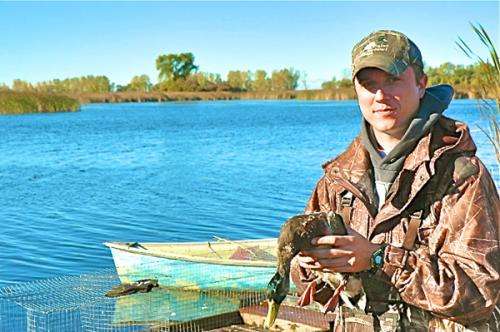Researcher looks to save an endangered duck habitat

Ever try to slap a mini-backpack on a mallard duck? Hang out with Matt Palumbo long enough and you'll find out how.
The Lake St. Clair region of southwestern Ontario has witnessed significant waterfowl habitat loss for a number of reasons – a conversion of wetlands to agricultural fields, industrial development like wind turbines, human population growth, even the increased use of the limited land by additional waterfowl wintering farther and farther north.
Because of these factors, the Western PhD student said, little is known about how waterfowl are using the region's remaining habitat. Understanding that could lead to better conservation planning of the region, and, eventually, to higher survival rates for the animals.
"What we're trying to look at is how they're using this landscape in this area and how then, subsequently, this relates to their survival," Palumbo said. "In terms of this area being so unique, it's pretty much an open slate as to what's going to happen."
By capturing and equipping the female ducks with solar-powered GPS mini-backpack transmitters, Palumbo will obtain accurate locations, allowing him to assess daily habitat use and estimate the survival of each duck during the fall and winter months.
The GPS units – slightly larger than a matchbook and weighing around 25 grams, or less than 3 per cent of the ducks body weight – do not inhibit flying or any other aspect of survival for the ducks.

"What we'll be doing is using a backpack style unit, literally a backpack for the duck, which attaches with a Teflon ribbon around the outside of the bird," said Palumbo, adding radio transmitters will also be attached for a more precise location of the birds. "They will eventually preen the ribbon into their feathers."
He will also be able to accurately assess when the ducks arrive at, and depart from, the Lake St. Clair region.
Assessing the habitat use will provide area conservation officials with information on how best to manage the remaining waterfowl habitat.
"Lake St. Clair is a crossroads for millions of waterfowl that travel through the area every year," said Palumbo, whose research is part of a larger Lake St. Clair Initiative conducted by Long Point Waterfowl.
Located in Port Rowan, Ont., Long Point Waterfowl focuses on waterfowl and wetland research, conservation and education. Its staff supervise Western undergraduate and graduate students working on a multitude of research projects on the ecology, management and conservation of wildlife and wetland habitats associated with the lower Great Lakes ecosystem.
Palumbo's research will determine the use of different habitat types and how this use is influenced by local land management practices. He will be able to categorize different foraging strategies exhibited by the ducks to determine if these strategies influence the animal's survival and how long they use the resources within the Lake St. Clair region.
Identifying influences to survival, he added, could be very useful for conservation managers if it's deemed mallard survival during the nonbreeding season – fall and winter – needs to increase to manage the population of these ducks.
"Ideally, I would like to get 60 or 70 ducks monitored. This would give us a larger sample size and, therefore, more statistical power to confirm what the ducks are doing," he said.
That will depend on funding. While there are initial funds available, a 'mallard tracker' program has been introduced for individuals or groups who, for $1,000, can sponsor a GPS-marked mallard (longpointwaterfowl.org) and receive movement and survival updates of their sponsored duck.
Palumbo hopes to pull preliminary data around this time next year.
"If we can provide more data surrounding non-breeding season survival information, those are the kind of conservation questions we want to answer," he said. "It will provide substantial information as to how these birds navigate the landscape."
Provided by University of Western Ontario















